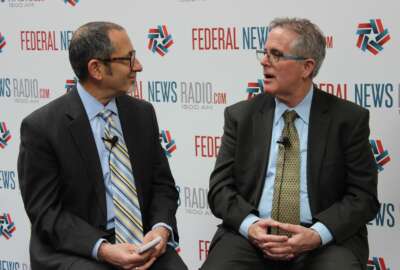
GSA wants to rescue innovations from the ‘valley of death’
GSA launches a pilot to help companies in Phase III of the Small Business Innovation Research (SBIR) program get access to federal buyers.
Pallabi Saboo is the CEO of Harmonia Holdings Group, a small women-owned business, with revenues approaching $20 million.
Harmonia Holdings Group is working for the Marine Corps to modernize its legacy system by using a tool the company developed to automatically migrate old software code into leading-edge languages.
Saboo said Harmonia Holdings couldn’t have won the contract without the Small Business Innovation Research (SBIR) program. Harmonia Holdings has won 89 SBIR grants over the last 15 or so years.
But Saboo said her company won the Marine Corps contract and many others not because agencies are using the SBIR program like Congress intended, but despite of it.
“The best kept secret in Phase III of the SBIR program is that any agency can put millions of dollars on the contract without competition. It’s very similar to an 8(a) contract,” Saboo said in an interview with Federal News Radio. “The problem is most contracting officers have no clue how to do that. I’ve tried to sell that until I was blue in the face. I have 89 different SBIRs, but I can’t get them to use it. That is challenging.”
Instead, Harmonia Holdings is using SBIR as a kind of venture capital fund where Saboo can obtain funding for research and development and then once the tool or software is ready, offer it back to the government through other contract opportunities.
“I use SBIR technology opportunities as areas where I want to develop competencies for my company,” she said.
GSA to offer Assisted Acquisition Services
And this is why the General Services Administration’s new pilot to use its Assisted Acquisition Services in the Federal Acquisition Service aims to connect companies like Saboo’s with federal agency buyers.
“We partnered with Small Business Administration to make this pilot program happen, said Mark Lee, GSA’s assistant commissioner of the FAS Office of Policy and Compliance, during a press briefing on July 30. “We think AAS is positioned to set up a shared service across the government to help support innovative solutions throughout the marketplace and that can lead to the job creation the program is designed to bring. There is a unique opportunity to work with companies early on and bring them to a contract vehicle and get them opportunities.”
Lee said the client support centers in Region 5 and the FedSIM office will run the pilots and have dedicated support to help expand the use of companies under the SBIR program throughout the rest of the federal acquisition offerings by GSA.
Saboo said any more attention Phase III SBIR companies can receive to help commercialize their technologies, the real key is whether FAS trains its acquisition workforce to use the program to the full extent the law allows.
“Once you finish Phase III, you are in the valley of death because there is no specific need anymore,” she said. “If you find someone who is interested in your project, you need money to really expand the project to do what they want, and the customer, especially in the Defense Department, may not be able to get you money for two years because of how the budgeting process works. We, and many other companies, have never been able to use the Phase 3 contract because contracting officers don’t know how to use it and the gap between funding is too much.”
Lee said part of the reason why GSA is stepping in is to address similar problems Saboo is referring to.
He said 13 agencies participate in the SBIR program and many lack a dedicated contracting shop so having AAS support SBIR contracts with a dedicated area
SBIR participating agencies
- Department of Agriculture
- Department of Commerce – National Institute of Standards and Technology; National Oceanic and Atmospheric Administration
- Department of Defense
- Department of Education
- Department of Energy
- Department of Health and Human Services
- Department of Homeland Security
- Department of Transportation
- Environmental Protection Agency
- National Aeronautics and Space Administration
- National Science Foundation
Jeff Koses, GSA’s senior procurement executive, said AAS is offering access to the SBIR Phase III companies currently and the pilot runs through fiscal 2019.
“We will have a governance process in place to ensure we understand the rules and making most effective use of the program,” he said. “We will communicate with SBA about future possibilities, such as extending the pilot to other parts of GSA or other areas of the SBIR program. When a customer agency comes to us with authority to use a company in the SBIR program, GSA will be the acquisition arm to support that makes the connection between the agency need and industry partner.”
John Shoraka, a former SBA associate administrator for government contracting and business development and now managing director of GovContractPros, said GSA’s idea is a good one, but the agency and SBIR companies also need to keep in mind several things.
“There should be significant SBA involvement as their Office of Innovation and Investment (OII) manages the SBIR program and reports on it to Congress,” he said. “The reporting of SBIR awards is unclear, and it is also unclear how many agencies use all of their dedicated SBIR funding, and how successful the funding is. There should be a report card grading system like the small business report cards to Congress for SBIR.”
Saboo said another way to improve the SBIR program would be for agency acquisition officers and commercialization assistance programs to spread the word about how the program works consistently and persistently.
“GSA doesn’t have to do matchmaking. I can take products and create opportunities if contracting officers are open to listening and understanding what they can do with the SBIR program,” she said.
Read more of the Reporter’s Notebook
Copyright © 2024 Federal News Network. All rights reserved. This website is not intended for users located within the European Economic Area.
Jason Miller is executive editor of Federal News Network and directs news coverage on the people, policy and programs of the federal government.
Follow @jmillerWFED





